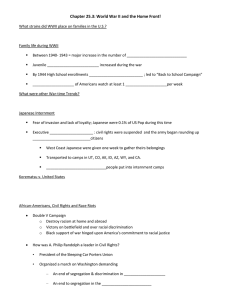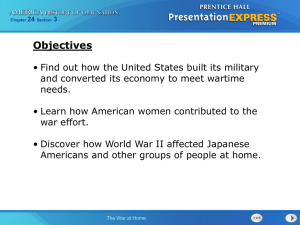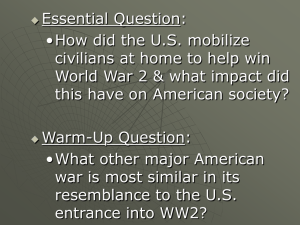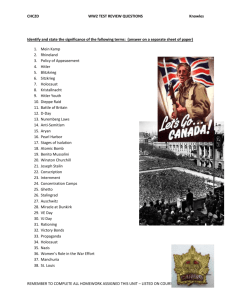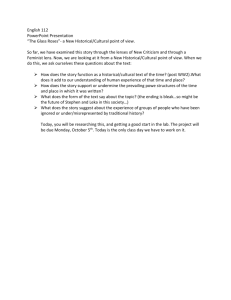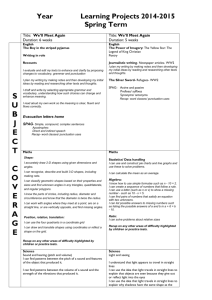Chapter 18 Section 2 Notes The Home Front
advertisement
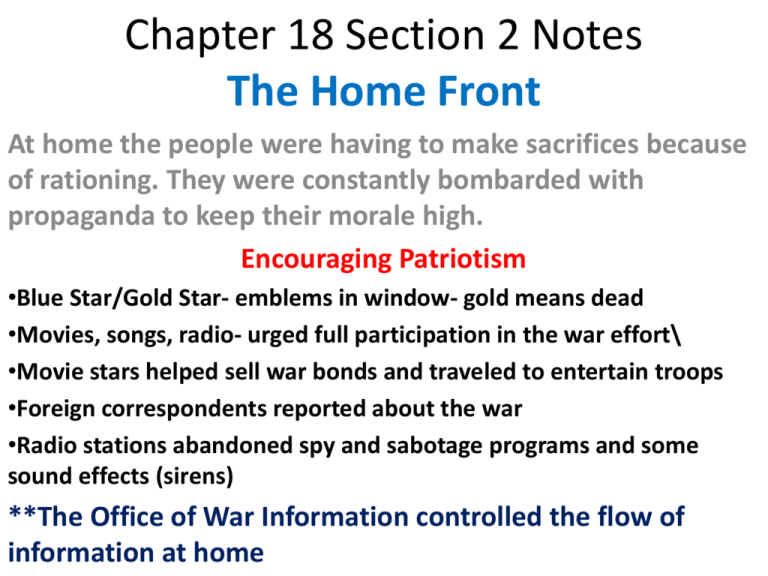
Chapter 18 Section 2 Notes The Home Front At home the people were having to make sacrifices because of rationing. They were constantly bombarded with propaganda to keep their morale high. Encouraging Patriotism •Blue Star/Gold Star- emblems in window- gold means dead •Movies, songs, radio- urged full participation in the war effort\ •Movie stars helped sell war bonds and traveled to entertain troops •Foreign correspondents reported about the war •Radio stations abandoned spy and sabotage programs and some sound effects (sirens) **The Office of War Information controlled the flow of information at home Life During Wartime Americans at home changed their habits due to the demands the war placed on them and to help the war effort • Victory Gardens- many Americans plowed up their yards to grow their own food • West Coast Cities imposed blackouts • Broadway and musicals showed the lighter side of war • By choice or gov’t decree Americans cut back on consumption and certain activities to help the war effort • Music was more realistic- “Praise the Lord and Pass the Ammunition • Paperbacks and nonfiction became the best sellers Rosie the Riveter The life of women changed dramatically during WW2. During the Great Depression women were encouraged NOT to work. Now doing “men’s” work became patriotic. One of the main symbols of this was Rosie the Riveter. 6,000,000 more women entered the workforce and many women changed jobs from traditional women’s work to the higher paid war work. Many women gained new self-pride, self-worth and independence because of this Discrimination During the War *Racial tensions did not disappear during the war but the gov’t had to try and reduce it in the war industries* • Many African Am’s moved into better paying jobs • 1,000,000 served in the armed forces • Served in segregated units often low-level work • Many war plants wouldn’t hire them- or as janitors • White workers staged “hate strikes” Fighting Discrimination A. Philip Randolph- (1941) Planned a march on DC to protest the discrimination. FDR feared unrest and met with Randolph • FDR issued an executive order forbidding racial discrimination • FDR created the Fair Employment Practices Committee (FEPC) to investigate companies to make sure his order was followed- not always followed- poor enforcement powers • Competition for housing in crowded cities caused tensions- 1943 in Detroit 34 people died in riots that before bein g put down by federal troops Mexican Americans and WW2 WW2 was a real mixed-bag for Mexican Americans Good: • 300,000 served in the armed forces- 17 MOH • Many Mexican Americans found good jobs-MW/WC • Thousands of braceros came to the SW to work Bad: • Discrimination in hiring and promotion Carlos E. Castaneda- U of Texas professor worked with the FEPC to discontinue discriminatory practices Zoot-Suit Riots Racial tensions reached their highest in LA in what became known as the Zoot- Suit Riots Sailors started attacking Mexican American youth and the police and media unfairly covered it. An inquiry eventually placed the blame on prejudice by the police, media and sailors. LA was off-limits to sailors for weeks Zoot-Suits Japanese American Relocation “Internment” Internment was one of the most blatant denial of rights in WW2. Japanese Americans on the West Coast were forcibly relocated to camps in WY,UT etc • • • • • • 119,000 relocated Issei- 1st generation were not allowed to be citizens Nisei- 2nd generation were citizens No evidence of disloyalty was ever found Hawaiian Japanese Americans were put under martial law Thousand of Japanese Americans served heroically in WW2 – 442nd in Europe and interpreters in the Pacific theater Round Up Internment Camps Case Study Norman Mineta • Nisei • 10 years old when interned- wore his Boy Scouts uniform- to show loyalty • Successful life– HOR from 1974 to 1995 – Introduced reparations legislation- successful – Secretary of Commerce
